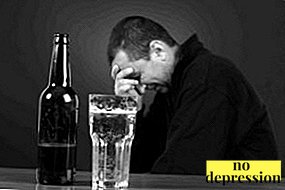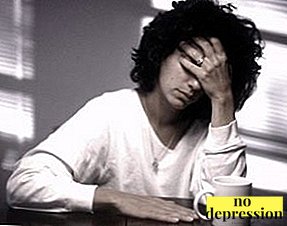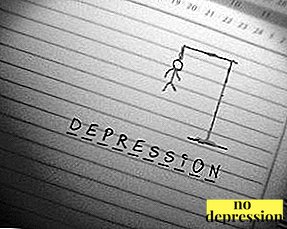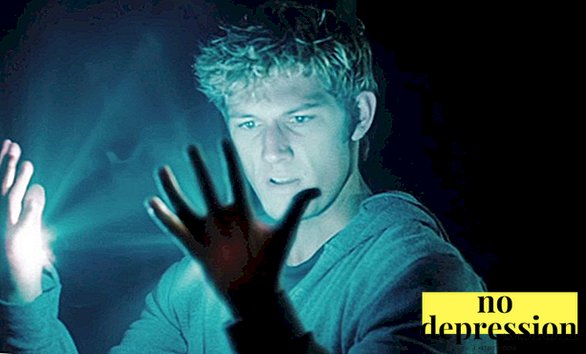The term "depression" in our days has become a kind of label, which hang on any malaise, accompanied by apathy.
In fact, this word means severe mental disorder, including psychological and physiological factors.
How to recognize the symptoms of chronic depression in a timely manner, what treatment methods exist and whether it is possible to prevent the disease - you will learn about it from the article.
Clinical picture

Depressive state consistently low mood, apathy, loss of taste for life.
Depression is formed by two sources:
- Body. Lack of enthusiasm for depressive disorder is always accompanied by organic problems. The disease is characterized by a drop in the level of neurotransmitters in the brain, in particular serotonin (known as the "hormone of happiness"). The problem may be due to both the deterioration of the generation of the substance and the complication of the so-called reuptake process.
- Psyche. Against the background of a low number of the most important neurotransmitters, a person is more prone to frustration: even minor problems and failures turn into a depressed condition of the patient.
The disorder, as a rule, arises as a result of the action of one mechanism, to which in time another one inevitably connects.
Doctors total 9 possible types of depression according to such criteria as the duration and brightness of the expression of signs of illness, the root cause and the predominance of certain symptoms. Chronic depression is characterized by:
- longer duration (at least 2-3 years);
- the occurrence as a result of frequent emotional overload and overwork on the background of a general tendency to melancholia;
- implicit symptoms.
Can depression be chronic? Find out from the video:
Psychological Triggers
Risk factors depression are:
 family history (cases of illness in the family);
family history (cases of illness in the family);- stress;
- taking medications with the side effect of blocking serotonin and dopamine, as well as increasing the level of norepinephrine and cortisol;
- insomnia;
- psychological and mental problems;
- diseases affecting the central nervous system (central nervous system);
- alcohol abuse;
- psychological pressure from another person;
- experienced spiritual or physical abuse;
- defects of appearance (imaginary or real);
- fatalism and "life with the flow", the absence of joy in any area of life (unloved work, "friends" - boring boring colleagues and so on);
- negativism (sticking out the "bad" to the detriment of the "good");
- low self esteem and / or self-doubt
According to statistics, women suffer from depression more often than men.
This is due to the natural general increased level of anxiety, the abundance of the corresponding hormones. However, the separation of factors provoking the disease into "female" and "male", contrary to common misconception, not.
Fatigue and depression
The term "chronic fatigue" was entrenched in the world classification of diseases in 1987. The essence of the disease is in constant weakness and lethargy, accompanied by the inability to fully sleep and rest.
Many often confuse fatigue and depression, however these two phenomena are radically different, although one can provoke the other (mutual dependence).
Among the main differences can be called the following:
 Depression is an affective disorder, that is, a person's emotions are subject to active change. In the mechanism of chronic fatigue more bodily processes are involved.
Depression is an affective disorder, that is, a person's emotions are subject to active change. In the mechanism of chronic fatigue more bodily processes are involved.- Unlike depression, chronic fatigue has no physiological reasons in its clinical picture (meaning such as blocking neurotransmitters during depression). According to doctors, chronic fatigue is the result of complex (spiritual, intellectual and physical) prolonged overloads.
- New nature: if depressive disorder has been known to humanity for several centuries, then the syndrome of pathological fatigue is a new phenomenon. Sociologists connect this with the rhythm of life of a modern person accelerated to unbelievable limits, increasing responsibility in all spheres of being.
Chronic fatigue and depression - where is the line? Psychology:
Course of the disease
Chronic Depressive Disorder can be observed in the form:
- the process of continuous development of depression;
- frequent and major periods of depression with small short breaks;
- inconsistent episodicity, unpredictable alternation of short "outbreaks" of disorder and quiet periods
There is also 4 forms of disease severity:
- easy
- moderate;
- moderately severe;
- heavy
The severity of the disorder is determined by severity of symptoms.

The disease can develop in one of 2 ways:
- Somatized. Characterized by a sharp deterioration in health. There is rapid heartbeat, anxiety, tearfulness, sleep and digestive disorders (often constipation), a general deterioration of health.
- Characterological. Depressive symptoms merge with the character of a person, if the disease is struck by a melancholic or phlegmatic person who is prone to self-analysis. There is spleen, pessimism, agedonia (lack of attraction to pleasure), frustration and melancholy, a sense of meaninglessness of existence.
Symptomatology
Chronic depression is characterized by the following signs of manifestation:
- Passive attitude of the patient to his own life situation, indifference.
- Inhibition of the psyche, inability to concentrate.
- The patient prefers to spend time in the supine state, the overall physical activity decreases.
- Stable or frequent bad mood.
- Sleep disturbance
- The emergence of RPP (eating disorders: anorexia, bulimia, compulsive overeating).
- The feeling of constant fatigue and difficulty in making decisions.
- There is often unreasonable constant guilt, self-esteem and self-esteem is steadily declining.
- Thoughts of suicide.
The presence of 3 or more symptoms from the list may be alarm signal. Perhaps you should contact a specialist.
Difference from dysthymia

In 2013 came out updated version of the classification of mental illnessaccording to which dysthymia is a subspecies of chronic depression.
Dysthymia is characterized by the first two aforementioned options for the development of a disorder: a feeling of depression on a permanent basis or for long periods with small intervals.
Essentially, dysthymia is form of chronic depression with more pronounced emotional symptoms.
A patient may not even be so clearly manifested a decrease in self-esteem or RPP as apathy, “withdrawal into oneself,” anhedonia.
How to cope with chronic depression? Find out from the video:
Diagnostics
To date, there is no 100% diagnostic method. In general, measures for detecting depression include:
- Physical examination (indicators of height, weight, pulse and pressure are collected) and complete blood count. These measures are not aimed at diagnosing the mental disorder itself, but at detecting other dysfunctions: for example, hypofunction of the thyroid gland or the effects of bad habits.
- Conversation with a specialist. A qualified psychotherapist takes part in the diagnosis of a depressive disorder. Only he can determine the presence or absence of the disease.
What is the danger?
Effects:
 First of all, depression is dangerous. disease recurrence in some moment. No one can predict what will cause a new wave of depression.
First of all, depression is dangerous. disease recurrence in some moment. No one can predict what will cause a new wave of depression.- It is also a chronic form of the disorder. dangerous "silent", not paying attention to the process of formation and development of the disease. A person may not even be aware of the existence of such problems.
- Depression causes human life irreparable harmand it's not just about possible suicide. The deterioration of attention concentration leads to inevitable problems at work / study, and because of the increasing isolation, the patient significantly narrows his social circle - and consequently, the audience of people who could notice the problem and help in solving it. Moreover, the complications that are more clearly manifested as the degree of illness increases are even more difficult to eliminate. A striking example is eating disorders.
Therapy
How to treat the disease? Depression is a multi-causative disorder, so treatment should be comprehensive, comprehensive.
Medications
Since the physiological factor is always involved in depression, the patient must be prescribed for the treatment. antidepressants. Most often in modern medicine are used:
- tricyclic drugs;
- selective serotonin / serotonin and noradrenaline reuptake inhibitors;
- monoamine oxidase inhibitors;
- Trazodone, Bupropion, Mirtazapine

Antidepressants need time for pronounced action and improvement of the clinical picture; minimum term - 2-3 weeks.
In this regard, the first course of taking antidepressants lasts at least six months, after which the doctor regulates further therapy depending on the situation.
All antidepressants have certain side effectstherefore, only a doctor can prescribe them. Moreover, almost all antidepressants today are sold strictly by prescription.
Psychotherapy
Conducting a conversation with the participation of a specialist is also an integral part of treatment.
It helps the sick restore the skill of social life, better control your emotions and probably will be able to help the patient find the same trigger, the “trigger” that provoked the depression and is the root of the problem.
Used by:
- individual therapy;
- family session;
- group therapy;
- support groups
Are used cognitive (aimed at normalizing the patient's thinking process), psychodynamic and behavioral (the purpose of which is to eliminate the symptoms of depression) methods of organizing therapeutic sessions.
Additionally
 first need to refuse from bad habitsbecause they only contribute to the degradation of the neurotransmitter production system;
first need to refuse from bad habitsbecause they only contribute to the degradation of the neurotransmitter production system;- in a severe form of the disease, the doctor may prescribe mood stabilizers (for example, Lithium);
- important to maintain relationship with loved ones;
- need to maintain a full and proper nutrition;
- in case of treatment failure, apply electroshock therapy.
Prevention
Depression can be cured, but the easiest way to prevent it. Again, depression cannot be 100% protected, but the risks can be minimized:
- Stop. Be sure to have a rest for yourself: 5-minute breaks at work (in which it is better not to smoke, but warm up a little, especially if the work is sedentary), weekly rest, annual leave (or at least every six months) and, of course, healthy sleep.
- Drop bad habits. Alcohol and nicotine stimulate the deterioration of the process of reuptake, and caffeine in large quantities too much stimulates the nervous system, which can lead to "mirroring" - apathy without caffeine or at the end of its action on the body.
- Watch your diet. The diet should be balanced and rich in vitamins.
- Serotonin is generated in the body by the conversion of the amino acid tryptophan. Be sure to include in your daily diet rich tryptophan foods: milk and cheese (including soy milk and tofu), nuts (especially peanuts and cedar), bananas, strawberries, apples, peaches, beef liver, chicken breast, lamb.
- If you wanted sweet - eat 2-3 slices of dark chocolate. This is an excellent food source of serotonin.
- Neurotransmitters - This is a kind of "useful internal drugs" of the body. They allow a person to experience pleasure, therefore, they are developed as an incentive reaction. Simply put, did something for evolution / survival / benefit - "get a candy." Therefore, for the normalization of hormonal background is necessary:
 do not starve, eat a little and often;
do not starve, eat a little and often;- be sure to give the body exercise - even a daily half-hour walk will be enough for the beginning;
- find a hobby / favorite thing and devote at least 15 minutes a day to it;
- have sex and have healthy relationships that bring joy;
- take care of yourself and your body.
Chronic depression - not at all such a harmless afflictionwhat it wants to appear. Do not forget about timely diagnosis, and better - timely prevention of the disorder. Everything is fixable!
How to get rid of chronic fatigue and depression? About the causes and treatment of chronic depression in this video:

 family history (cases of illness in the family);
family history (cases of illness in the family); Depression is an affective disorder, that is, a person's emotions are subject to active change. In the mechanism of chronic fatigue more bodily processes are involved.
Depression is an affective disorder, that is, a person's emotions are subject to active change. In the mechanism of chronic fatigue more bodily processes are involved. First of all, depression is dangerous. disease recurrence in some moment. No one can predict what will cause a new wave of depression.
First of all, depression is dangerous. disease recurrence in some moment. No one can predict what will cause a new wave of depression. first need to refuse from bad habitsbecause they only contribute to the degradation of the neurotransmitter production system;
first need to refuse from bad habitsbecause they only contribute to the degradation of the neurotransmitter production system; do not starve, eat a little and often;
do not starve, eat a little and often;

